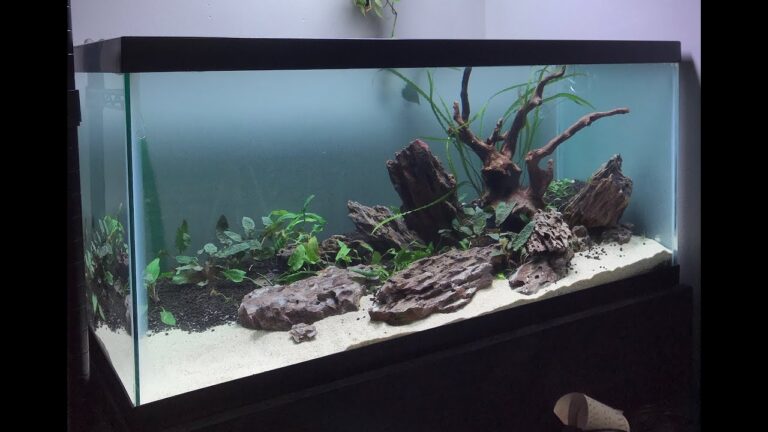What Should pH Levels Be in Freshwater Tank?
The ideal pH level for a freshwater tank is between 6.5 and 7.5. This range will provide the best environment for most tropical fish species, as well as many aquatic plants that require a neutral or slightly acidic pH level to thrive. To maintain this desired range in your aquarium, it’s important to use an accurate testing kit regularly throughout the year.
With regular testing, you’ll be able to monitor any changes in your water chemistry so that you can adjust accordingly if needed and ensure optimal conditions for both fish and plant life in your tank.
The optimal pH level for a freshwater tank should be between 6.5 and 7.5. This range is considered safe for most fish species, allowing them to live healthy lives in their environment. Fish require specific levels of acidity and alkalinity in order to stay healthy, so it’s important that the water you use closely matches these parameters as well as possible.
Test your tank regularly with an accurate pH testing kit and adjust accordingly if needed to ensure that your fish have the best living conditions possible!
Fish Tank Ph Level Too High
Having a fish tank with a pH level that is too high can be dangerous for the inhabitants of your tank. High pH levels can cause stress, illness and even death in fish, as it disrupts the balance of their internal environment. To reduce the pH of your aquarium, you should use water conditioners designed specifically to lower aquarium pH levels or do frequent partial water changes with fresh dechlorinated tap water.
Additionally, adding driftwood or aquatic plants can help bring down the alkalinity over time as well.
Symptoms of Low Ph in Fish Tank
Low pH in a fish tank can be detrimental to the health of the fish, and cause serious illness or death. Symptoms of low pH in a fish tank may include listlessness, discoloration of scales, erratic swimming behavior, labored breathing or gasping for air at surface level. In extreme cases, low pH levels can produce white patches on the gills and fins that are indicative of tissue damage due to acidity.
Therefore it is important to regularly test your aquarium’s water conditions and adjust as necessary to maintain a healthy environment for your fish.
What Should My Freshwater Aquarium Levels Be
When setting up a freshwater aquarium, it is important to make sure that the water has the correct levels of essential elements in order for your fish and other inhabitants to thrive. The pH should be kept between 6.5 and 7.5, ammonia should remain at 0 ppm, nitrite should stay at 0 ppm, and nitrate levels should remain below 20ppm or 10-15ppm if you have live plants in your tank. Additionally, dissolved oxygen levels need to be maintained above 5 mg/L while hardness (GH) should range from 2-20 dH (degrees Hardness).
Finally, keep an eye on temperature as most tropical tanks will fall between 72°F – 80°F although some species may require more specific ranges so do research before adding any new fish.
What Should No2 Levels Be in Freshwater Tank
The ideal levels of Nitrogen dioxide (NO2) in a freshwater aquarium should be 0.0 to 0.3 ppm, as anything higher than this can have harmful effects on the fish and other aquatic life living in the tank. It is important for hobbyists to regularly check their tanks for NO2 levels and make sure they are below 0.3ppm, as any increase above this level could lead to decreased oxygenation in water, which could result in death or illness amongst the fish population.
What Should Ph Levels Be in Freshwater Tank Chart
Maintaining the proper pH level in a freshwater tank is essential for fish’s health and well-being. The ideal range of pH levels for most freshwater tanks is between 6.5 and 7.6, with higher levels being slightly more acceptable to some species than others. Regularly testing your water quality can help you determine if the pH level needs to be adjusted or maintained, as it is important to keep these levels consistent throughout the aquarium system.
What Should Ph Levels Be in Freshwater Tank Aquarium
The ideal pH level for a freshwater aquarium should be between 6.5 and 7.5, depending on the types of fish you have in your tank. It is important to keep your pH levels consistent as fluctuations can cause stress or health problems for the fish living in your tank. Regular water changes will help maintain stable pH levels while regular testing with a quality test kit is recommended to ensure that the correct balance is maintained over time.
Fish Tank Ph Level Too Low
Maintaining a healthy ph level in your fish tank is essential for the well-being of your aquatic life. If the ph level drops too low, it can lead to stress on your fish and other organisms that inhabit the tank. To avoid this, you should regularly test the water and make sure it falls within an acceptable range (6.5 – 8).
If needed, make adjustments with a pH buffer or use reverse osmosis to remove dissolved minerals from tap water before adding it to your tank.

Credit: www.myaquariumclub.com
How Do I Maintain the Ph Balance in My Fish Tank?
Maintaining the pH balance in your fish tank is a critical part of keeping your fish healthy. The ideal pH level for most tropical and saltwater fish tanks should be around 7-8, but some species will require higher or lower levels. To ensure you are providing the best environment possible, it’s important to regularly check the pH levels in your tank and make adjustments if needed.
You can do this by testing the water with a simple kit from the pet store or online. If you find that the pH level is too low, adding crushed coral to the substrate can help raise it back up; similarly, if it’s too high, driftwood can help reduce it down again. Additionally, regular water changes are essential for maintaining a balanced ecosystem as they get rid of any excess waste and other pollutants that could throw off the delicate equilibrium in your tank.
Finally, always research each type of fish before adding them to your aquarium to make sure their natural habitat matches up with what you have created so far!
Is a Ph of 8 Too High for Aquarium?
The pH of an aquarium is a key factor in the health of its inhabitants, so it’s important to maintain proper levels. A pH level that is too high can have damaging effects on the fish and other aquatic creatures living in the tank. Generally, an ideal range for an aquarium’s pH is between 6 and 8, with 7 being considered neutral.
Anything above 8 could be considered too high for most species of fish – especially if prolonged or extreme – as this may result in stress for the animals due to difficulties regulating their internal body chemistry. Additionally, such high levels of alkalinity can lead to changes in oxygen solubility which could affect respiration rates and cause multiple complications over time; as well as increase mineral deposits on equipment such as pumps or heaters that are essential components within a saltwater system. Therefore, when setting up your new tank make sure you regularly test the water parameters and take corrective action if necessary by using buffers like sodium bicarbonate or potassium bicarbonate to bring down any excessively elevated readings back into acceptable ranges before stocking your new home with living creatures!
What Happens to Fish If Ph is Too High?
When the pH of a fish’s environment is too high, it can have serious consequences for the health and wellbeing of our aquatic friends. Fish are very sensitive to even slight changes in their environment, and when the pH climbs higher than usual, they can experience a range of uncomfortable symptoms. A rise in pH causes carbon dioxide levels to drop, leading to an inability for oxygen molecules to dissolve into the water as easily and ultimately resulting in reduced amounts available for fish respiration.
This can cause distress signs such as rapid breathing (known as “gasping”), lethargy or loss of appetite due to lack of oxygen reaching tissues adequately. Additionally, elevated pH may also lead to irritation on skin or gills which could result in infection or disease if not addressed quickly by a trusted aquarist. Ultimately, it is important that we ensure that our aquariums remain at optimal parameters so that our fish remain healthy and happy – keeping an eye on pH should be part of your regular maintenance routine!
Is 7.5 Ph Good for Aquarium?
Having a balanced pH level in an aquarium is essential to ensure the wellbeing of fish, plants and other aquatic creatures. As such, understanding what pH levels are suitable for your specific aquarium is important. Generally speaking, most aquariums should have a pH between 6 and 7.5; however there can be exceptions depending on the type of fish you keep or if you have live plants in your tank.
A safe range for most tanks could lie anywhere from 6 to 8, with 7 being neutral. A slightly alkaline water at around 7.5 would make an ideal environment for many common freshwater species as it tends to promote better health overall. However, some fish may require more acidic or alkaline conditions so it’s important to research any species before deciding on a certain pH level that works best for them individually.
Aquarium pH, GH, and KH for BEGINNERS
Conclusion
In conclusion, having the correct pH level in your freshwater tank is essential for a healthy and thriving environment. It is important to use a reliable test kit to measure the pH levels of your tank on a regular basis. Keeping an eye on these levels can help ensure that your fish, plants, and other aquatic life have all they need to thrive in their new home.






